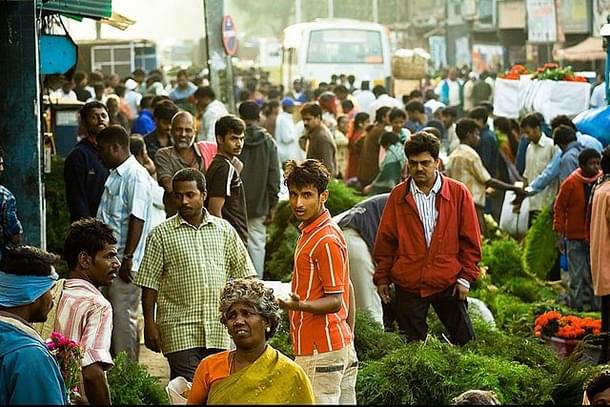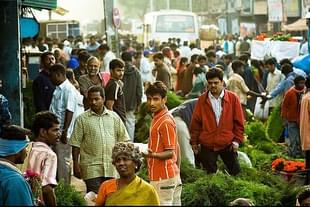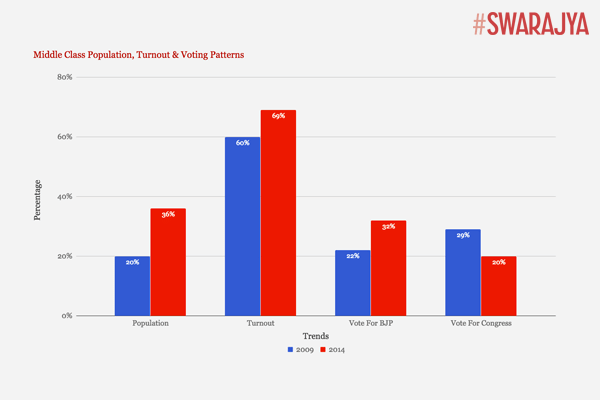Politics
Is The Middle Class Looking Beyond BJP?
Amitabh Tiwari
Apr 13, 2018, 04:31 PM | Updated 04:24 PM IST
Save & read from anywhere!
Bookmark stories for easy access on any device or the Swarajya app.


Petrol prices in many Indian cities today are higher than what they were when Prime Minister Narendra Modi took office on 26 May 2014. Globally, crude oil prices have softened from an average of $109 per barrel in 2013 to $44 per barrel in 2016. Prices have been rising for the past two years; however, they are still much below the levels seen in 2013. The middle class, which has been reeling under the impact of a slowdown in gross domestic product (GDP) and low salary hikes and bonuses, was expecting tax breaks in the Union budget 2018. However, left empty-handed, the petrol price hikes have left many of them aggrieved.
The middle class is the largest voting block today. This burgeoning class has been growing in number continuously, from 20 per cent of the population in 2009 to 36 per cent in 2014. In 2014, the Bharatiya Janata Party (BJP) ran a high-pitched campaign promising jobs and an end to corruption, drawing middle-class voters into its fold. Previously disillusioned with politics and politicians, the middle class turned out to vote in large numbers in 2014, recording a 9 per cent increase in turnout. Middle-class voters backed the BJP resoundingly, leading to a 10 per cent increase in its vote share, in contrast to a corresponding 9 per cent decline in Congress votes from this segment.

However, four years in power and Jaitley’s policies, where he adopted the approach of hiking excise duty in fuel products to meet fiscal deficit targets, have started turning the voters away from the party. The BJP suffered significant losses in the bypolls in Ajmer (approximately 84,000) and Alwar (approximately 2 lakh). It is important to note that in both these constituencies, the BJP won in 2014 by huge margins of 1.72 lakh and 2.84 lakh respectively. These two cities are among the top 10 urban centres of Rajasthan.
In Uttar Pradesh bypolls, the low voter turnout in Allahabad (25 per cent) was one of the primary reasons for the party’s loss in Phulpur. This points clearly to a sense of dissatisfaction among middle-class voters.
The cost of living has been rising over the years. The service tax rate, which was 12.36 per cent when the BJP came to power, has increased by almost 50 per cent, to 18 per cent. This has made our electricity, telephone, and internet bills expensive. No significant tax sops have been provided to the middle class. Petrol prices are at a four-year high despite crude oil prices declining globally. The senior citizens, who depend on interest income, are suffering because of a low-interest regime on account of demonetisation. The middle class has not received significant tax breaks, which could have otherwise acted as a balm. Standard deduction has been re-introduced, but the benefit has been taken back in the form of an increase in cess from 3 per cent to 4 per cent. While the government will lose Rs 8,000 crore due to standard deduction, it will gain Rs 11,000 crore from an increase in cess.
The middle-class voter, who is mostly educated, understands these issues and has started to ask questions. Some of them may still not vote against the BJP, but even abstaining from voting can be disastrous for the party, especially when it has peaked in various stronghold states. The BJP is aware of the growing disenchantment and, as some may argue, has taken a leftist turn on economic policies. The party, which appeared critical of the MGNREGA earlier, has actually enhanced allocations to the scheme in the budgets it has presented. The motto clearly is antyoday, which is not wrong, but what about the basic tenets of equality?
The BJP is trying to build a new vote bank of poor and lower-class voters in an attempt to not repeat Atal Behari Vajpayee’s mistake of ‘India Shining’. It’s often said that middle-class voters are not loyal. Even in the 2004 election, more middle-class voters supported the Congress than the BJP despite being the real beneficiaries of the ‘India Shining’ campaign. However, this strategy is fraught with risks.
- The number of poor and lower-class voters has been reducing over the years, from 74 per cent of the population in 2009 to 53 per cent in 2014.
- Middle and upper-class voters also vote in large numbers nowadays. The poor class recorded the lowest turnout in 2014 at 60 per cent, lower class 68 per cent, middle class 69 per cent, and upper class 67 per cent.
- “The middle class which tends to decide who governs, has an incentive to ally with the poor to exploit the rich. It also has an incentive to support the rich to avoid being exploited by the poor.” As per Iversen and Soskice, in a majoritarian electoral system, of which the Indian first-past-the-post is one, the latter motive dominates.
So, as the share of middle-class voters grows, no government can ignore their concerns. The Congress party paid a heavy price for this in 2014. The BJP cannot risk alienating this segment of voters and should not ignore their disenchantment. Otherwise, middle-class voters could align with the rich to negate the appeasement strategy directed currently to the poor and the lower class by the BJP.
Amitabh Tiwari is a former corporate and investment banker who is now following his passion for politics and elections. Views expressed are personal. He tweets at @politicalbaaba.





